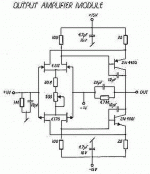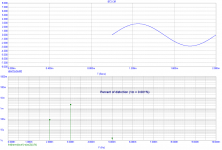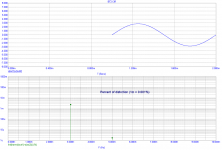Pavel, we are getting bogged down answering random concerns. Perhaps we can go forward, instead. What have you found that works pretty good for mosfets? Anything new out there? Is an all j-fet design really significantly better?
You forgot about non-linear input capacitances of output MOSFETs that cause signal rectification and dependence of their idle currents on frequency, hence dynamic distortions.
Yep. It's probably hard to find a better simple example of open loop gain generating large amounts of PIM.
Yep. It's probably hard to find a better simple example of open loop gain generating large amounts of PIM.
And it would be hard to measure because of symmetry that hides non-linearities from an observer. The best way to catch it up is to observe triangle shape changes on an oscilloscope gradually increasing frequency on a full swing.
Of course, we should have the more standard Parasound JC-2 preamp sort of stage to compare to. I don't have a simplified schematic handy, does anyone?
Of course, we should have the more standard Parasound JC-2 preamp sort of stage to compare to. I don't have a simplified schematic handy, does anyone?
I can send you one by email, if you think its ok you can put it up yourself, or let me know.
Cheers
Hi Zinsula
John was talking about the Parasound JC-2
The above schematic IS of the JC-2 "output module". IF it is not, then there is one more error on the internet or Jc designed at least two JC-2 preamps....
It seems that there are at least two JC-2 designs:The above schematic IS of the JC-2 "output module". IF it is not, then there is one more error on the internet or Jc designed at least two JC-2 preamps....
http://www.marklev.com/JC2/index.html
http://www.parasound.com/halo/jc2.php
It seems that there are at least two JC-2 designs:
http://www.marklev.com/JC2/index.html
http://www.parasound.com/halo/jc2.php
Apologies Stinius
This thread can be so confusing!!😀
It should be noted that these two JC-2 preamps were designed almost 35 years apart from each other, but they are very similar in concept. The CTC Blowtorch topology is the best of all, at least in my opinion.
The simplified topology for the Parasound JC-2 should be up soon. Stinius is going to put it up.
Pavel, we are getting bogged down answering random concerns. Perhaps we can go forward, instead. What have you found that works pretty good for mosfets?
As you know, I have not built this circuit discussed. My results are based on simulation only, in this particular case.
My simulation shows that both bandwidth and distortion (and spectral distortion content) highly depend on output mosfets. This is no surprise, for sure, as this is an "open-loop" design and change in mosfet's capacitance and their transfer functions (of both halves) contribute to resulting BW and distortion significantly.
The simplified topology for the Parasound JC-2 should be up soon. Stinius is going to put it up.
Attachments
Thanks Pavel, as well. It would appear that 2nd harmonic is very sensitive to single ended drive vs balanced drive, interesting.
I realize that this circuit is also limited by the (4) 220 ohm (or so) resistors which provide current to the stage quadrants. What if those resistors were turned into (ideal) current sources? Would that remove the mosfet from adding significant distortion or noise to the final output?
I think that we realize that the 220 ohm sources provide a sneak path that upsets normal cascode behavior to some extent, including noise gain in the mosfets, etc.
I realize that this circuit is also limited by the (4) 220 ohm (or so) resistors which provide current to the stage quadrants. What if those resistors were turned into (ideal) current sources? Would that remove the mosfet from adding significant distortion or noise to the final output?
I think that we realize that the 220 ohm sources provide a sneak path that upsets normal cascode behavior to some extent, including noise gain in the mosfets, etc.
Last edited:
Nelson Pass had also an opinion about replacing these resistors with ccs:...................I realize that this circuit is also limited by the (4) 220 ohm (or so) resistors which provide current to the stage quadrants. What if those resistors were turned into (ideal) current sources? Would that remove the mosfet from adding significant distortion or noise to the final output?
I think that we realize that the 220 ohm sources provide a sneak path that upsets normal cascode behavior to some extent, including noise gain in the mosfets, etc.
http://www.diyaudio.com/forums/showthread.php?p=723517
Tino
As many here may have come to realize: The CTC type circuitry is impractical in many ways, and that is why Parasound products do not use it.
In fact, the typical JC designed, Parasound preamp input and second stage, while still balanced in 4 quadrants, is much more forgiving on parts selection, especially Idss, and certainly has much more gain potential, almost too much for open loop operation.
In fact, the typical JC designed, Parasound preamp input and second stage, while still balanced in 4 quadrants, is much more forgiving on parts selection, especially Idss, and certainly has much more gain potential, almost too much for open loop operation.
- Status
- Not open for further replies.
- Home
- Member Areas
- The Lounge
- John Curl's Blowtorch preamplifier part II


